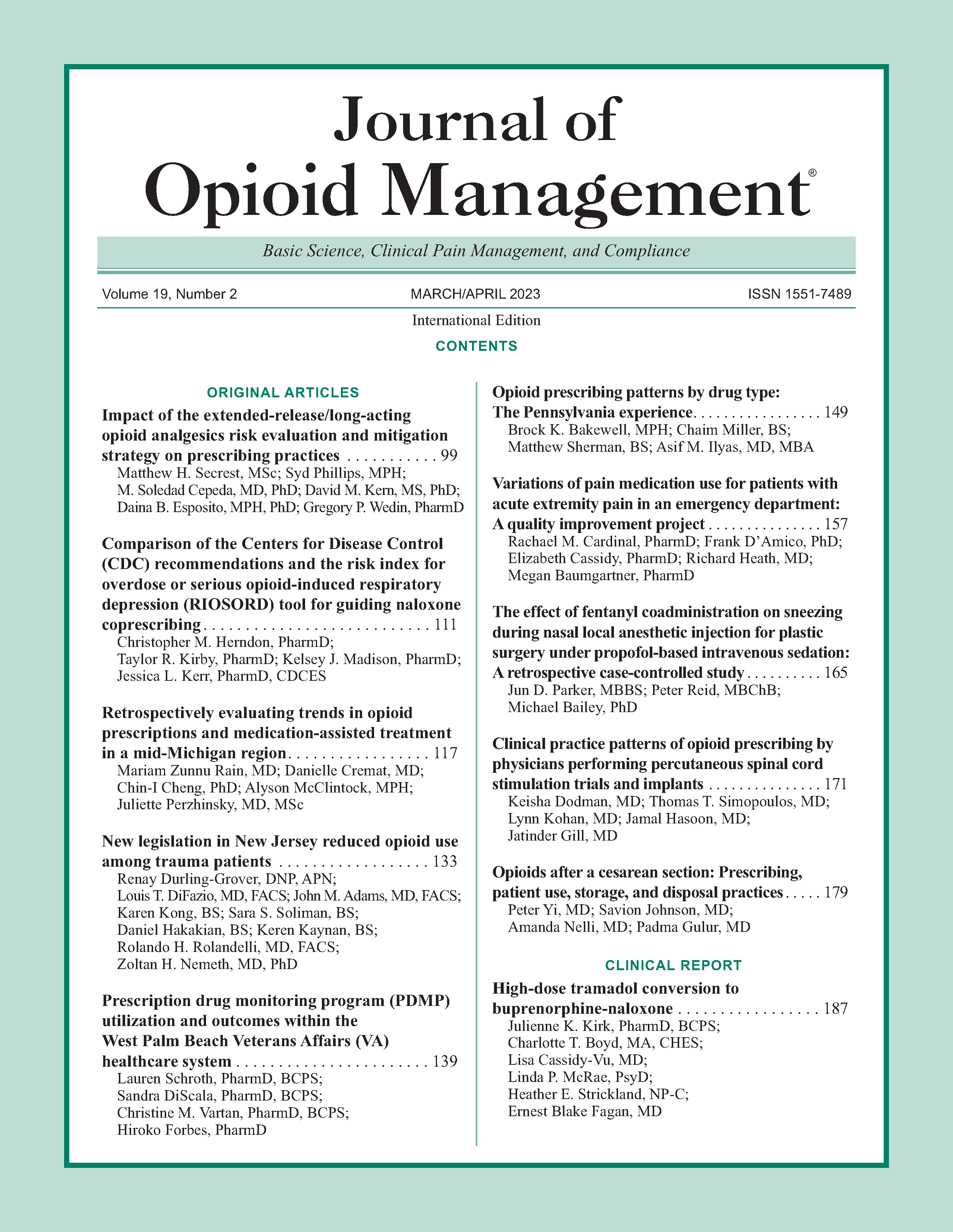High-dose tramadol conversion to buprenorphine-naloxone
DOI:
https://doi.org/10.5055/jom.2023.0774Keywords:
tramadol, withdrawal, buprenorphine-naloxoneAbstract
Buprenorphine-naloxone is a combination medication of an opioid partial agonist and opioid antagonist that is proven to be effective in outpatient management of opioid use disorder (OUD). Tramadol is a centrally acting analgesic. This commonly used pain medication inhibits serotonin and noradrenaline reuptake by acting as a selective agonist on opioid μ receptors. Transition and tapering high-dose tramadol to buprenorphine-naloxone is not well described in the literature. We report a case of a patient who was taking 1,000-1,250 mg of tramadol daily upon presentation to the clinic. She was originally prescribed 150 mg daily with escalation in dose and frequency over a 10-year period. The patient was converted to buprenorphine-naloxone and has been successful in treatment of OUD for 1 year.
References
Handelsman L, Cochrane KJ, Aronson MJ, et al.: Two new rating scales for opiate withdrawal. Am J Drug Alcohol Abuse. 1987; 13(3): 293-308.
Duehmke RM, Derry S, Wiffen PJ, et al.: Tramadol for neuropathic pain in adults. Cochrane Database Syst Rev. 2017; 2017(6).
Cepeda MS, Camargo F, Zea C, et al.: Tramadol for osteoarthritis. Cochrane Database Syst Rev. 2006. DOI: 10.1002/14651858.CD005522.pub2.
Nakhaee S, Hoyte C, Dart RC, et al.: A review on tramadol toxicity: Mechanism of action, clinical presentation, and treatment. Forensic Toxicol. 2021; 39: 293-298.
Miotto K, Cho AK, Khalil MA, et al.: Trends in tramadol: Pharmacology, metabolism, and misuse. Anesth Analg. 2017; 124(1): 44-51.
Senay EC, Adams EH, Geller A, et al.: Physical dependence on Ultram® (tramadol hydrochloride): Both opioid-like and atypical withdrawal symptoms occur. Drug Alcohol Depend. 2003; 69(3): 233-241.
Marquardt KA, Alsop JA, Albertson TE: Tramadol exposures reported to statewide poison control system. Ann Pharmacother. 2005; 39(6): 1039-1044.
Sansone RA, Sansone LA: Tramadol: Seizures, serotonin syndrome, and coadministered antidepressants. Psychiatry (Edgmont). 2009; 6(4): 17-21.
Mauger S, Fraser R, Gill K: Utilizing buprenorphine–naloxone to treat illicit and prescription-opioid dependence. Neuropsychiatry Dis Treat. 2014; 10: 587-598.
Fullerton CA, Kim M, Thomas CP, et al.: Medication-assisted treatment with methadone: Assessing the evidence. Psychiatr Serv. 2014; 65(2): 146-157.
Kirk JK, Yount T, Boyd CT, et al.: Launching a medication-assisted treatment in an outpatient office-based practice. J Prim Care Community Health. 2020; 11: 215013272094072- 215013272094076.
Fiellin DA, Pantalon MV, Chawarski MC, et al.: Counseling plus buprenorphine–naloxone maintenance therapy for opioid dependence. N Engl J Med. 2006; 355(4): 365-374.
Cupples N, Moore TA: A case of tramadol dependence and successful treatment with buprenorphine/naloxone. Mental Health Clin. 2013; 3(6): 283-285.
Terasaki D, Klie K: Tramadol withdrawal in the setting of buprenorphine induction: A case report. J Addict Med. 2020; 14(3): 264-266.
Edinoff AN, Kaplan LA, Khan S, et al.: Full opioid agonists and tramadol: Pharmacological and clinical considerations. Anesth Pain Med. 2021; 611(4): e119156.
Published
How to Cite
Issue
Section
License
Copyright 2005-2025, Weston Medical Publishing, LLC and Journal of Opioid Management. All Rights Reserved.











